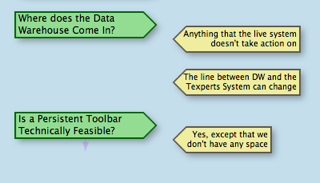IVICA: Space and Patterns
We make Tinderbox maps because spatial relationships can be richer and more flexible than lists.
This argument is distinct from one that is sometimes advanced to support ‘mind mapping’ – that people are more adept at working with spatial relationships than with other symbolic forms. I'm not convinced that people are particularly good at working with spatial relations. But spatial language is inherently richer at expressing some relationships, and the continuity of space is often convenient for describing approximate relationships that are difficult or inconvenient to specify more exactly,

Here’s a piece actual Tinderbox map, produced for a corporate presentation and discussion. The dialectic pattern here — question and answer, call and response — is something we often encounter in meetings, in negotiation, and in planning. We’re doing this not to validate or verify a logical inference — this isn’t a poor man’s Toulmin diagram — but rather to record the making of a design decision.
It’s easy to see what”s going on here, even if you don’t read every note. Notice, though, that there’s no good HTML markup for this description. You could use <dt> and <dd>, I suppose, but that”s a hack. You could use a bunch of special purpose <div>'s. You could format it as a dialogue, like a screenplay.
Question: what would a green, right-facing tag in the right column mean?
Question: what would a blue, left-facing tag in the right column mean?
I bet you can propose sensible answers to both questions. But you’ve never seen this diagram before, there’s no legend, and I don’t think any of us studied this visual language in school. This is interesting.